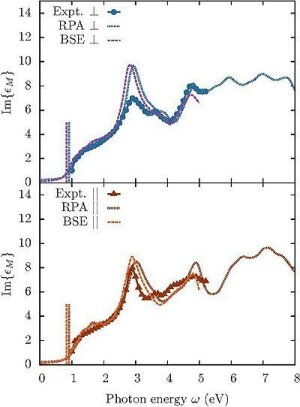"Theoretical Spectroscopy"
Theoretische Spectroskopie
Image: Marques, and S. Botti, Phys. Rev. B 91, 075134 (2015)"Theoretical Spectroscopy"
The Condensed Matter Theory group works on the forefront theoretical approaches for excited states, contributing to the development of the theory, its implementation in efficient numerical codes and its application to a variety of systems of technological relevance.
Prof. Botti's recent research activity has been mainly devoted to the understanding of electronic properties of materials for energy, with a particular focus on photovoltaics, and to the design of new candidate materials for applications in energy production, storage and saving. New materials, that have not been synthesized yet, are proposed using ab initio global structural prediction and high-throughput calculations. The thermodynamically stable compounds can then be pre-characterized in silico using the same techniques employed for already known materials. The problems related to electronic excitations are particularly challenging as they often demand specific tools that go beyond standard density functional theory, such as its extension to time-dependent phenomena or Green's function methods. However, standard density functional theory (often together with some ad hoc corrections) has been applied many times in the literature to study excited state properties of materials used, e.g., in photovoltaics or optoelectronics, despite of the fact that this theory is formally designed to determine ground state properties only. In this context, Prof. Botti's group has developed new approximations and used state-of-the-art approaches for excited states to clarify contradictory experimental and theoretical findings. Thanks to the valuable input of experimental collaborations, the obtained results have already succeeded in solving various long-standing issues on the physics governing the electronic properties of materials, such as absorbers for thin-film solar cells, nanostructures for opto-electronics or catalysis, amorphous-crystalline phase change materials for data storage, graphite under pressure, p-doped zinc oxide and delafossites for transparent electrodes, materials for hydrogen storage, layered superconductors, topological insulators, etc.
As an example of quality of the results, the figure shows the optical absorption spectra of a copper indium diselenide thin-film used as absorber in the photovoltaic industry. The absorption spectra calculated using two different approximations (labeled as RPA and BSE) for different light polarizations are in excellent agreement with measured spectra.
